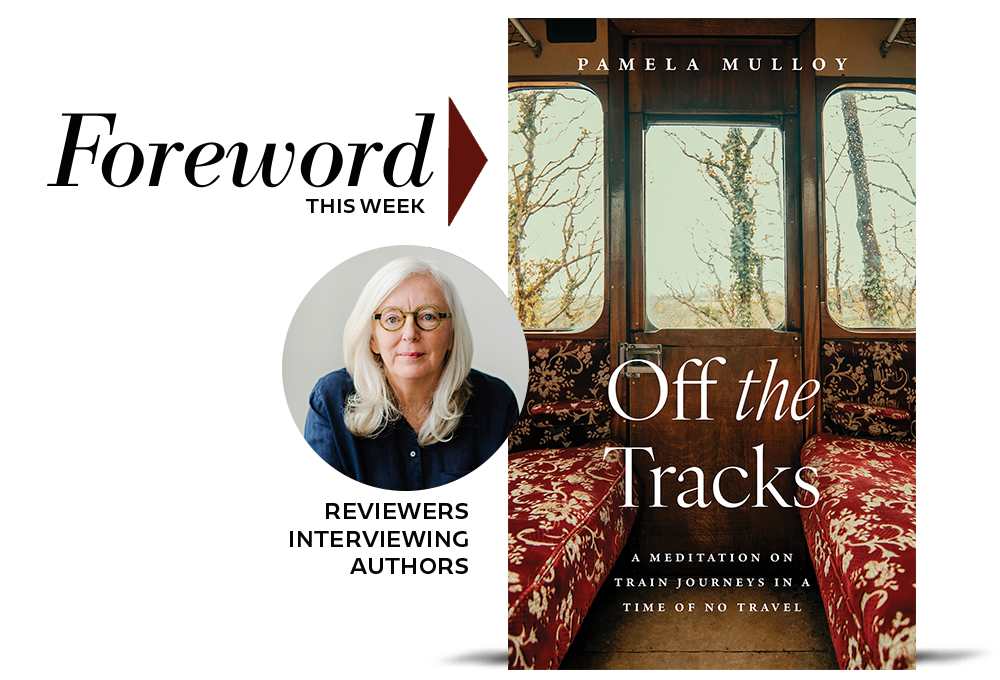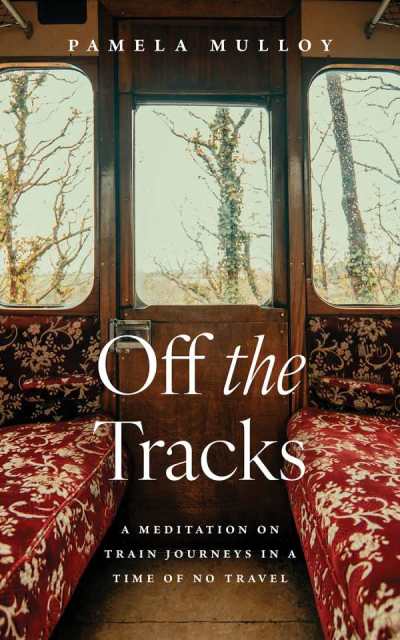Hearing from Pamela Mulloy, Author of Off the Tracks: A Meditation on Train Journeys in a Time of No Travel

“Eating in the dining car has always felt vaguely aristocratic to me, a place where the rules of social exchange are practiced. And as an introvert, I don’t have to go through the angst of trying to initiate a conversation when the set-up is already there. The first question is ready for you: ‘Where are you going?’”
—Pamela Mulloy
Ah, trains, surely the most favored form of travel—long romantic trips across the Russian steppe with buckets of champagne and caviar. Endless stretches of prairie in the American West from your private compartment, just you and your books and your sweetheart for days on end. Ninety minutes at ninety miles an hour between the center of Paris and Dijon, through some of the most beautiful rural countryside to be found on earth. Train travel is special.
Additionally, trains are safe, comfortable, relatively inexpensive, and usually very convenient to city centers. For these reasons and more, trains score high on virtually every standard we use to rate why travelers prefer trains over cars, buses, planes, and ships.

Pamela Mulloy doesn’t need convincing. Her Off the Tracks, reviewed in Foreword‘s May/June issue and the subject of today’s conversation with reviewer Kristen Rabe, details a lifetime love of the stations, trackside chaos on the outskirts of cities, dining cars, chatty passengers, and other reasons trains reign supreme.
Remarkably, you wrote this travel book during the COVID pandemic, when you had a radius of about a hundred miles. What role does memory play in Off the Tracks? Is there a broader message about the power of memory and imagination?
Memory played a big part in the book. In fact, it was the starting point. When I began cancelling the trips I’d booked, I had the idea of looking back at past journeys—some of which I had taken in my twenties—and of using those memories as a jumping off point to write about the social history of trains.
Interestingly, the trips I recalled often were triggered by a small detail—a connection to someone, or a sense of well-being I might have felt at the time. For example, when travelling in France, it wasn’t the cycling through the wine region that I remember, but the old man who helped us rent the bicycles.
Thinking about these memories made me reflect on travel, and consider the question of why we do it and what we get from it. Imagination played into this process as well, coloring my memories to some extent. The memory image in my head was like a film, and it became real to me; so, it’s hard to know what was actually recalled and what was colored in.
I loved your descriptions of the “messiness” of entering a city by train, with its “functions laid bare.” How does train travel affect your perception of a place?
I pay attention to the entry points because it always seems like you’re sneaking into a city when coming by train, seeing things you were not meant to see. I am writing this on the train, and earlier this morning I saw a jockey training his horse on a racetrack on the outskirts of the city in the driving rain. It was quite striking to see him lean into the horse with wind and rain tormenting him, as we rode by, witnesses to his work.
I like peering into the back yards, or the industrial wastelands, as we enter a city because it seems like these places are not really meant to be seen, but they still exist and serve a function. We enter amidst these scenes of chaos and arrive in the composed area of the train station. It is striking because trains go through landscapes that have not been controlled, or that remain untouched, and are not planned scenery for the passengers. It makes me pay attention to the things we see along the way.
Just now as I travelled through the forests of northern New Brunswick, I noticed a small shanty by the tracks. I wondered whether someone lives there, or maybe it’s a hunting cabin. It is isolated and unseen except for the fleeting moments when a train might go by.
This book includes engaging accounts of the people you’ve met on your trips. Talk about the “mixing of strangers” as a unique quality of train travel.
As an introvert, I think of my train journeys as a time of retreat, where I can think and write. But at some point, I will have a conversation with the person next to me, or more likely, when I go to the dining car. On a train, it feels like an arranged dinner party at a grand country house; you are seated with other people with the understanding that you will converse. Over the years, I have encouraged this with my daughter. When she was a child, she learned the flow and rhythm of adult conversations, the questions asked and answered. Because time is limited and you know that you will likely not see them again, people will open up, or they become curious. Eating in the dining car has always felt vaguely aristocratic to me, a place where the rules of social exchange are practiced. And as an introvert, I don’t have to go through the angst of trying to initiate a conversation when the set-up is already there. The first question is ready for you: Where are you going?
You describe yourself as a “ritual traveller,” and you return to many of the same locations later in your life. What is the attraction of returning to a familiar place? How does your understanding of a place change over time?
As travellers, we are conditioned to find the next “best” things, and there is a kind of stress with that—both in determining what it is and in planning for the unique experience. For me, going to a place that I’ve been to before takes away a layer of tension I might feel, as I already know what to expect and so can relax into it. This allows me to discover more of it, or experience it in a different way, or to roam around with curiosity. This perhaps allows me to go a bit deeper than if I were flitting from one “best” experience to another. Even in places I’ve already been to, it’s fulfilling the need to travel, and the urge to experience something new. Over time, you can even feel a sense of ownership in this place, become an expert in its ways, and that too is satisfying.
The book features lively accounts of travel on several continents. Does the experience of riding a train in Europe differ from that in the US? What about Canada?
Many train journeys in the US and Canada are much longer, so there is a sense of settling in, claiming space on the train. The German writer Stefan Zwieg considered his train compartment his office as he travelled across Europe. There is a sense of that with these long trips I’ve taken in Canada and the US, even if you are sitting in coach!
Travelling by train in Europe is more a way of life, it seems. There are a lot of options to travel between cities that are fast and economically viable. People seem to be more used to train as a mode of transportation, or commuting, rather than just for holidays.
When I lived in Poland, I travelled on trains that still had compartments. There is a kind of intimacy or familiarity that forms when you are in the shared space with strangers. But, as I’ve written, this can also be challenging if you feel uncomfortable with your travel companions. There is no escaping them.
In this book, you cite the legacies of several historical travel writers. One of the most intriguing is Mary Wollstonecraft. What did she contribute to the art of travel writing? Which other writers had an influence on you?
Reading about Mary Wollstonecraft’s journeys in History of a Six Week Tour was fascinating, not only because of how challenging the travels were, but because we are able to get genuine insight into her experience. The same was true of the travels she wrote about in Letters Written from Sweden, Norway, and Denmark. At that time the personal reflections and observations that are common in travel writing now weren’t really part of the form. Travel writing was mostly just descriptions of the places visited, and it was almost entirely done by men. Wollstonecraft puts herself in this new place or situation so we can see her clearly, such as when we understand her fretting because she wishes she’d brought her baby with her. This sort of personal narrative was novel and a significant contribution to the travel writing genre.
I also love the work of Jan Morris, Freya Stark, Stefan Zweig, Bruce Chatwin, and Rosemary Mahoney. The Virago Book of Women Travellers was a wonderful resource to dip into for snippets of writing from many adventuring women who wrote about their travels. I particularly liked one story of a woman who was committed to caring for her family until she was into her forties; at that point, she went to see the doctor for a back problem and he prescribed travel as a cure. There are so many parts of this anecdote to consider—the wonderful doctor who seemed to understand her needs more deeply than she did, the recounting of a life given up to caregiving that was the case of so many women, and a passion undertaken and embraced later in life.
What are your plans for your next trip?
I will be travelling to England in the summer, taking the train from London to the north of the country for a week, then flying to Spain, where I will be staying about an hour outside of Barcelona, and of course, taking the train into the city to see the sights.
I’m already thinking about the grand train stations I’ll travel through in London—King’s Cross and St. Pancras—only to disembark at the other end at a small village station in the north. The journey itself is the epitome of slow travel as my mind settles into the shift from urban sprawl to the pastoral landscape. I haven’t entered Barcelona by train before; but, having been to the elaborate Gaudi inspired station in Valencia, I am hoping for a similar form of grandness. This is where anticipation starts: the train station.
Kristen Rabe
